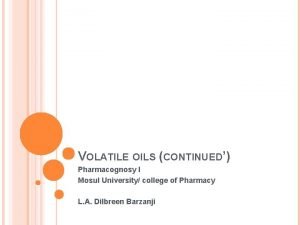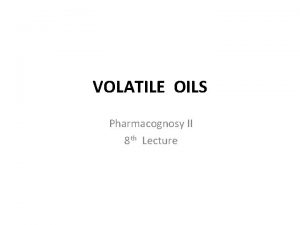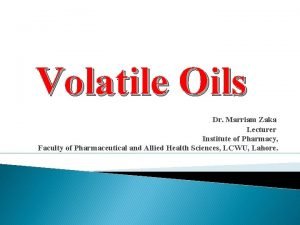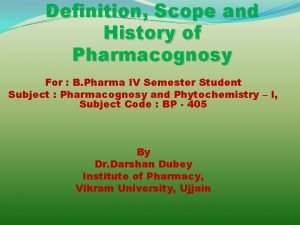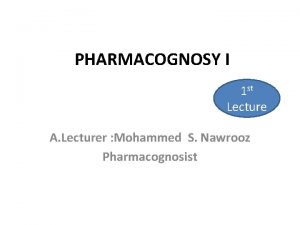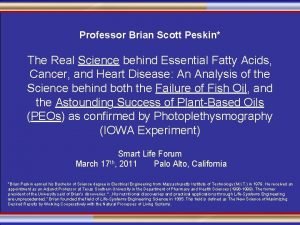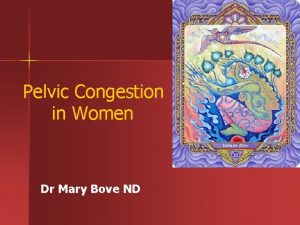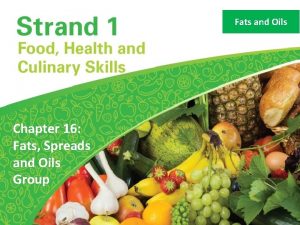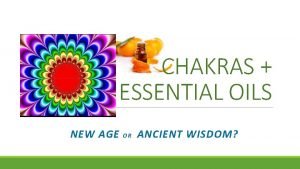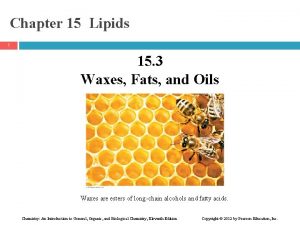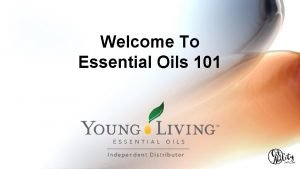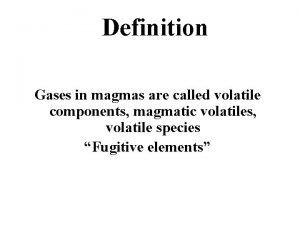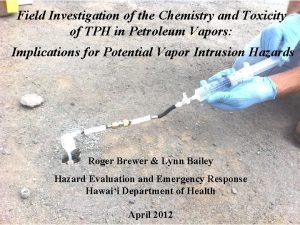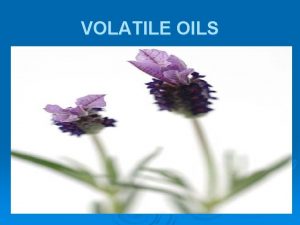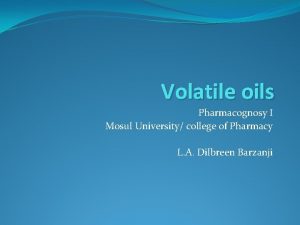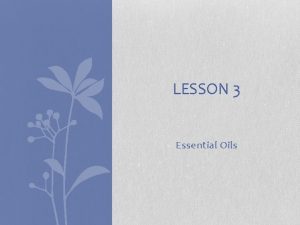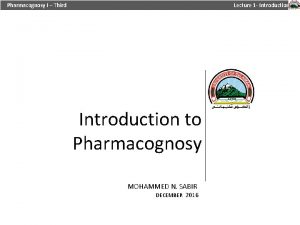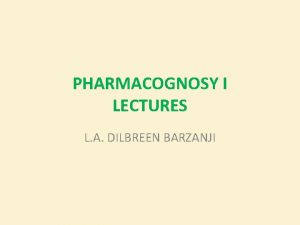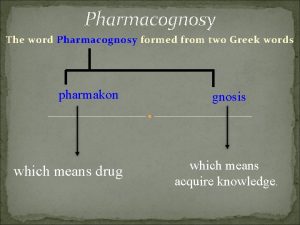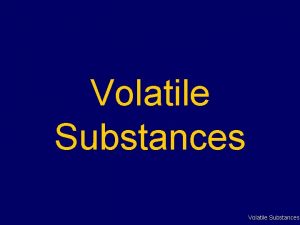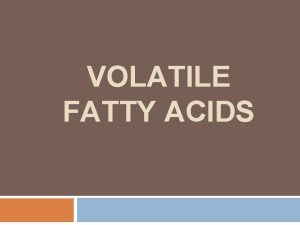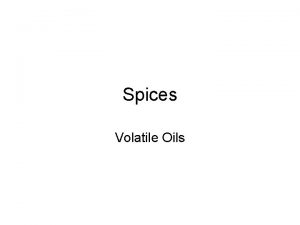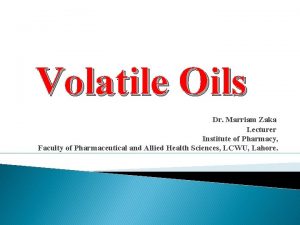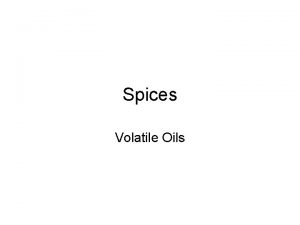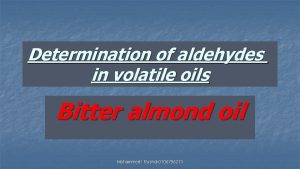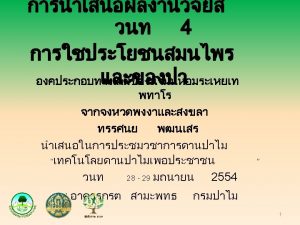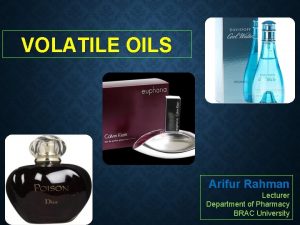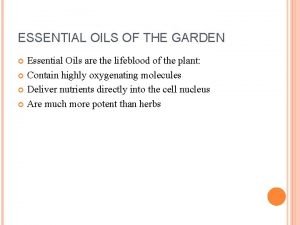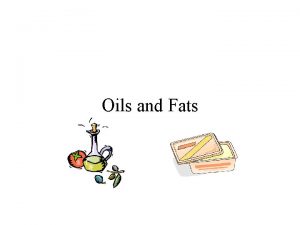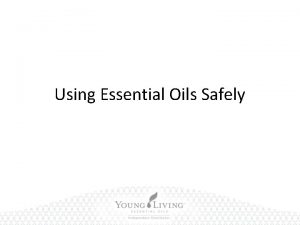VOLATILE OILS Pharmacognosy II 8 th Lecture 2





















- Slides: 21

VOLATILE OILS Pharmacognosy II 8 th Lecture

2. Alcohol Volatile Oils : A good number of alcohols occur in a plethora of volatile oils, which may be classified into the following heads, namely: (a) Acyclic (aliphatic) alcohols, (b) Monocyclic (aromatic) alcohols, Geraniol: the major part of oil of rose and in the essential oil of lemon grass. Uses 1. used as rose scents. 2. It is also employed as insect attractant. 3. It is used in soap, cosmetic and flavour industries.

2. Nerol: Nerol is found in a number of essential oils, specifically oil of Neroli (usually obtained from the fresh flower of orange). 3. Linalool: it is occurs in a variety Of essential oils in artemisia , black tea, and in cinnamon.

4. Terpinen-4 -ol: It is used as antibacterial, antifungal, antiviral. Recent data demonstrated that terpinen-4 -ol suppresses inflammation. 5. Alpha-Terpineol: The anticancer activity of alpha-terpineol towards different tumour cell lines was evaluated in vitro

3. Aldehyde Volatile Oils: A. aliphatic Aldehyde Volatile Oils: Citral: from natural sources is a mixture of two geometric isomers Geranial and Neral. It is also present to a limited extent in oils orange and ginger root. It is used extensively in the synthesis of vitamin A. B. Aromatic Aldehyde Volatile Oils:

C. Heterocyclic Aldehyde Volatile Oils: Furfural: present as oil of lavender It is used as insecticide, and fungicide. _______________________ 4. Ketone Volatile Oils: A. l-Menthone: present in peppermint. it has two asymmetric carbon atoms (i. e. , chiral centres) it can exist in two pairs of enantiomers or four optically active isomers ( dl-menthone and isomenthone). B. Carvone : present in mandarin peel oil, spearmint oil

Bicyclic Ketone Volatile oils: Like camphor Camphor is used for treatment of fibrositis and neuralgia associated with inflamed joints, sprains, and other inflammatory conditions. It is primerily used for its mucolytic properties. Camphor has been shown to be safe and effective for reducing cough when externally applied to the chest and throat of young children. Inhalation of the aromatic vapors cause a local anesthetic action

5. Phenol Volatile Oils: The important drugs containing phenol volatile oils like Clove oil , and oil of thyme. They essentially owe antiseptic, germicidal , popular flavouring agents and another effects. A. Carvacrol: oil of thyme. 1. It is mostly employed as a disinfectant. 2. It is also used as an anthelmintic B. Eugenol: present in clove oil It is used in perfumeries, flavorings, essential oils and in medicine as a local antiseptic and anesthetic

C. Thymol: Uses 1. It is invariably employed as an antifungal and antibacterial agent. 2. It is a vital component in several analgesic and topical antiseptic formulations in low concentrations ranging between 0. 1 to 1% in personal health care products. 3. It is widely employed in preparation exclusively intended for mouthwashes, gargles, oral preparations and as a local anaesthetic in toothache.

D. Menthol: It is found in the peppermint oil obtained from the fresh flowering tops of the plants commonly known as Mentha piperita. Synthetic racemic menthol is prepared by the hydrogenation of either pulegone or thymol.

On reduction it will be converted to p-Menthane. Uses of menthole : 1. It is used profusely in various types of mouth washes, toothpastes and similar oral formulations. 2. used on the mucous membranes or on the skin to serve as a counterirritant, antiseptic and as a mild stimulant at a cencentration ranging between 1 to 16%. 3. It is used with other allied substances e. g. , camphor, eucalyptus oil (eucalyptol) in various pharmaceutical preparations, such as: expectorants, nasal sprays, and inhalants to cause immediate relief from symptoms of nasal congestion.

6. Phenolic Ether Volatile Oils : A good number of volatile oils essentially contain phenolic ethers which attribute powerful aromatic odour. Because of their distinct characteristic aroma they are used extensively as pharmaceutical aids, perfumery and confectionery. examples of phenolic ether volatile oils are Anethole; Safrole; Myristicin; cineol and Apiole 1. Anethole on exposure to air (oxygen), light or heat undergoes structural modifications to yield photoanethole which is a viscid yellow coloured mass having a disagreeable taste and odour with a poor solubility in solvents. Perhaps the conversion of anethole to photoanethole takes place via the formation of anisaldehyde

It is used as a flavouring agent in perfumery particularly for soap and dentifrices. 2. Safrole: It is widely used as a flavouring agent for a variety of products, such as: pharmaceuticals chewing gums, toothpastes, in perfumery and scenting soaps.

3. Apiole: It occurs abundantly in dill oil and It is also found in the Parsley seed oil Petroselinum crispum 1. Dill is frequently employed as an aromatic stimulant, carminative and flavouring agent. 2. Dill oil is an important ingredient of ‘Gripe Water’ which is given to infants to relieve them from flatulence. ________________________ 4. Myristicin

5. Cineole (eucalyptol): It is the chief constituent of oil of eucalyptus obtained from the leaves of Eucalyptus globulus. Also present in Artemisia, chamomile and clove. Uses 1. Internal usage—as a stimulating expectorant in cases of chronic bronchitis External usage—as a mild antiseptic, anaesthetic in cases of inflammatory conditions. 2. It is used as a pharmaceutical aid i. e. , flavouring agent. Other Therapeutic Properties of cineole are analgesic, anti-bacterial , anti-fungal, anti-viral, increases cerebral blood flow, reduces tension headaches, and smooth muscle relaxant.

7. Oxide Volatile Oils : The various chemical constituents containing oxide function present in naturally occurring volatile oils are namely: Safrole, Myristicin, Apiole, and Cineole. These compounds have already been discussed under section Phenolic Ether Volatile Oils. _________________________ 8. Ester Volatile Oils: The ‘Ester Volatile Oils’ essentially possess their flavouring characteristics, and specific perfume by virtue of the presence of a good number of naturally occurring esters, most common among which are the acetates of borneol, geraniol and terpineol. A. Geranyl Acetate: present in lavender and thyme.

B. Linalyl Acetate. presents in lavender and bergamot. C. Methyl Salicylate Uses 1. Methyl salicylate has local irritant, antirheumatic and antiseptic properties. It is an important ingredient of ointments that used for relief of pain in several conditions like, muscular pain, and joints pain. D. Methyl Anthranilate(Esters Containing Nitrogen)presents in orange

VITAMINS • Vitamins are organic dietary substances necessary for the maintenance of normal metabolic function. • Only small amounts of the vitamins are required for normal health. • In the body, they act as components of the important enzyme systems that catalyze the reactions by which protein, fat, and carbohydrate are metabolized. • Some of the vitamins (e. g. , vitamin K) may be formed by bacteria in the gut, while vitamin D is synthesized by exposure of the skin to sunlight. With these exceptions, the vitamins must be ingested in the food, and restricted diets or disorders of the gastrointestinal tract, interfering with absorption, lead to vitamin deficiency.

Vitamin A (retinol) : From retinols in animal products or beta carotene in plant foods. Retinols: Liver, salmon and other cold-water fish, egg yolk, and dairy products. Orange and yellow fruits and vegetables, such as carrots, and leafy green vegetables. The major dietary source for preformed vitamin A is vertebrate animal products that are rich in vitamin A esters (liver, kidney, dairy products, and eggs)

It Prevents night blindness; needed for growth and cell development; maintains healthy skin, hair, and nails, as well as gums, glands, bones, and teeth; may help prevent lung cancer. Symptoms of deficiency include night blindness, stunted growth in children, dry skin and eyes, increased susceptibility to infection. Symptoms of excess include headaches and blurred vision, fatigue, bone and joint pain, appetite loss and diarrhea, dry, cracked skin, rashes, and itching, hair loss. It can cause birth defects if taken in high doses before and during early pregnancy.

Vitamin K ( menadiol): Spinach, and other green leafy vegetables; pork, liver, and green tea. - Essential for proper blood clotting. - Symptom of deficiency include excessive bleeding. - Symptom of excess: may interfere with anticlotting drugs.
 Use of volatile oils in pharmacy
Use of volatile oils in pharmacy Volatile oils - pharmacognosy
Volatile oils - pharmacognosy Isovaler synonym
Isovaler synonym Discuss history and scope of pharmacognosy
Discuss history and scope of pharmacognosy Pharmacognosy scope
Pharmacognosy scope 01:640:244 lecture notes - lecture 15: plat, idah, farad
01:640:244 lecture notes - lecture 15: plat, idah, farad Professor brian s peskin
Professor brian s peskin Dr mary bove
Dr mary bove Owensboro grain edible oils
Owensboro grain edible oils Difference between fats and oils in organic chemistry
Difference between fats and oils in organic chemistry Fats spreads and oils
Fats spreads and oils Which biomolecule group includes fats oils and waxes
Which biomolecule group includes fats oils and waxes Fats, oils, and waxes
Fats, oils, and waxes New age oils
New age oils Non polar molecules that include fats oils and cholesterol
Non polar molecules that include fats oils and cholesterol Hydrogenation of oils
Hydrogenation of oils Fats, oils, and waxes
Fats, oils, and waxes Essential oils
Essential oils Magma volatile gasses definition
Magma volatile gasses definition Secondary storage provides temporary or volatile storage
Secondary storage provides temporary or volatile storage Volatile c
Volatile c Raoult's law and dalton's law
Raoult's law and dalton's law
